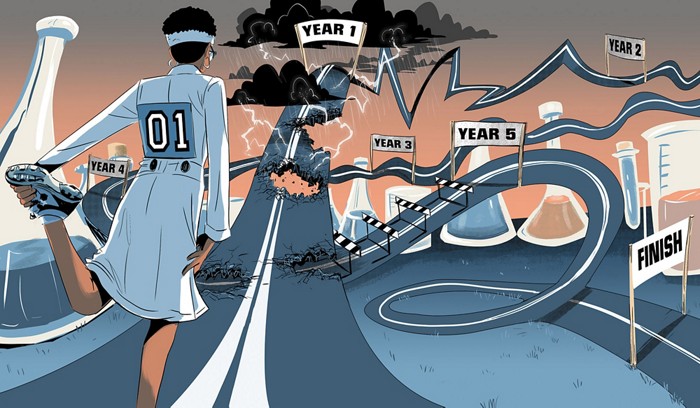Advertisement
Grab your lab coat. Let's get started
Welcome!
Welcome!
Create an account below to get 6 C&EN articles per month, receive newsletters and more - all free.
It seems this is your first time logging in online. Please enter the following information to continue.
As an ACS member you automatically get access to this site. All we need is few more details to create your reading experience.
Not you? Sign in with a different account.
Not you? Sign in with a different account.
ERROR 1
ERROR 1
ERROR 2
ERROR 2
ERROR 2
ERROR 2
ERROR 2
Password and Confirm password must match.
If you have an ACS member number, please enter it here so we can link this account to your membership. (optional)
ERROR 2
ACS values your privacy. By submitting your information, you are gaining access to C&EN and subscribing to our weekly newsletter. We use the information you provide to make your reading experience better, and we will never sell your data to third party members.
Graduate Education
Newscripts
Doctoral treats and moneyed scientists
by Laura Howes
January 14, 2019
| A version of this story appeared in
Volume 97, Issue 2
Rewarded for flicking through a thesis

When writing up your thesis, did you slip in something unexpected? Perhaps you included a treat for close reading or for just opening up the pages?
The Newscripts gang’s attention was recently taken by the bottom right corner of Rob Thompson’s PhD thesis. Thompson, a materials chemist at the University of Cambridge, enhanced his pages with a flipbook showing a defect moving across a lattice of sodium chloride. Unsurprisingly, the idea to add the animated bonus was not a last-minute addition. Instead, Thompson tells Newscripts, he’d had the idea around two years ago after a colleague had to bring pages and pages of printed images into a presentation. “We joked that with all the images he could make a flipbook,” Thompson explains. “I had the idea in the back of my head since then.”
Using the flipbook package for LaTeX, the program he used to write and lay out his thesis, Thompson added the simple schematic to the margins of his pages. And was his hard work noticed? While it wasn’t mentioned during his PhD defense, one of his examiners congratulated Thompson on the images afterward.
Thompson’s thesis got the Newscripts team thinking: What other treats have been added to theses?
In December, C&EN put out a call on Twitter for similar stories, and our readers didn’t disappoint. Andre St. Amant, now at Harvard University, admitted to using a Game of Thrones quotation to describe cyclopentadienes, while Andryj Borys used relevant lines from different Arnold Schwarzenegger films in each of his chapters. More romantically, Twitter user @KalliC used her thesis title “For the Love of SAM” to refer to the analogs of S-adenosyl methionine that she worked with and her wife’s first name.
Several others admitted they had slipped in some more lighthearted references in their theses, but other current and recent graduate students uttered cries of despair. “Who has the time let alone the presence of mind to put clever stuff like this into their thesis?! I’ll be lucky if I finish mine on time!” one respondent opined.
If you managed to find the time to treat your thesis readers, Newscripts would love to hear about it on one of C&EN’s social media channels or by email.
Scientific currency

In an undisclosed library in the UK, David Mills has a £20 note slipped into his thesis. “It’s my emergency fund should I ever really need it,” he explains.
Advertisement
Future British chemists who want to add a bit of currency to their theses, as a reward for themselves or another reader, could also add a bit of science if they use a new scientific £50 note. The Bank of England recently asked the public to nominate scientists to be featured on the next design of the note, the largest denomination in the UK. In total, nearly 1,000 eligible scientists were nominated, and the chosen scientist will be announced this summer.
It seems a shame that there can be only one winner, so the Newscripts gang was interested to learn about the new Notable Women app for US bills. Available for iOS and Android phones, the app uses image recognition to replace the usual faces shown on US currency with selected women from history. The replacement women, including scientists, are just some of those who were nominated by the American people to appear on actual US currency in response to a call by Rosa Gumataotao Rios, when she was treasurer of the US, to redesign the nation’s currency.
The app came about after Rios spoke to a group of Google engineers about her work to get a woman’s portrait on US currency. “I didn’t think it would end with augmented reality, but here we are,” Rios writes on the Notable Women website. The app includes an image and a short excerpt of biographical information. Users can swipe through different images or click through to read more about one of the women featured. Perhaps that’s one way of getting more scientists on our money?
Laura Howes wrote this week’s column. Please send comments and suggestions to newscripts@acs.org.



Join the conversation
Contact the reporter
Submit a Letter to the Editor for publication
Engage with us on Twitter